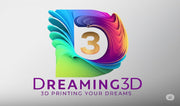3D printing has unlocked a world of creativity from custom cookie cutters to reusable cups and personalized kitchen gadgets. But if you’ve ever thought about using your 3D prints with food, you’ve probably asked the big question:
👉 What 3D printing filament is food safe?
The short answer: sometimes. The long answer? Let’s dive in.
What Makes a Filament “Food Safe”?
When it comes to food contact 3D printing, not all plastics are created equal. Just because a filament is labeled “non-toxic” or “biodegradable” doesn’t mean it’s automatically safe for food use. Food safety depends on three factors:
-
The base material – some plastics, like PET (used in soda bottles), are naturally food safe.
-
Additives & colorants – pigments, fillers, or recycled materials can make a filament unsafe.
-
The printing process – even safe materials can become unsafe if printed with a contaminated nozzle or left with porous layer lines that trap bacteria.
Best Food-Safe 3D Printing Filaments
PLA (Polylactic Acid)
PLA is one of the most popular filaments. Some PLA food-safe filaments are certified for food contact, though not all brands carry approval.
Pros: Easy to print, eco-friendly, available in FDA-compliant versions.
Cons: Low heat resistance — not suitable for hot liquids or dishwashers.
PETG (Polyethylene Terephthalate Glycol)
PETG is widely considered one of the best options for food safe 3D printing filament. It’s durable, chemical-resistant, and similar to the plastic used in water bottles.
Pros: Excellent durability, good chemical resistance, often FDA-approved.
Cons: Slightly trickier to print than PLA.
Nylon (Polyamide)
Unfilled nylon can be safe for food contact. It’s used in many industrial and medical applications. However, because nylon absorbs moisture easily, it may harbor bacteria if left unsealed.
Pros: Strong, flexible, long-lasting.
Cons: Hygroscopic (absorbs water), needs a coating to be food-safe long term.
Polypropylene (PP)
Polypropylene 3D printing is naturally food-safe — the same material used in food containers and medical syringes. But it’s also one of the hardest materials to print.
Pros: Naturally FDA food contact compliant, lightweight, chemical resistant.
Cons: Prone to warping, requires a specialized setup.
Hidden Risks in Food-Grade 3D Printing
Even if you use FDA approved 3D printing filament, there are two risks makers often overlook:
-
Nozzle contamination – Brass nozzles may contain lead. For food grade 3D printing, switch to a stainless steel nozzle to avoid contamination.
-
Layer lines and bacteria – FDM prints are porous. Without sealing, 3D printed kitchen tools can harbor bacteria that’s impossible to fully wash away.
How to Make Your 3D Prints Truly Food Safe
If you want safe, reusable items for the kitchen, here’s the checklist:
-
Choose FDA approved 3D printing filament – Look for certified PETG food-safe filament or trusted PLA brands.
-
Upgrade your nozzle – Stainless steel nozzles are a must for food contact prints.
-
Seal your prints – Apply a food-safe epoxy resin (like XTC-3D) to smooth layer lines and prevent bacteria buildup.
-
Avoid heat and dishwashers – Stick to room-temperature or cold food contact unless using high-heat-resistant polypropylene or specialty PETG.
Final Thoughts: What’s the Best Food-Safe Filament?
If you’re just getting started with food contact prints, PETG food-safe filament is your best all-around option. For eco-friendly one-off projects, go with certified PLA food safe filament. If you want truly durable, dishwasher-safe prints, polypropylene 3D printing is worth the challenge.
✅ Best bet: Use FDA-approved PETG or PLA, print with a stainless steel nozzle, and seal your parts. With the right setup, your 3D printed kitchen tools can be safe, practical, and customized to your needs.
